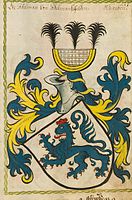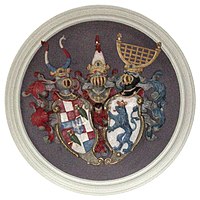Adelmann of Adelmannsfelden
Adelmann von Adelmannsfelden is the name of a Swabian noble family . The gender belongs to the primeval nobility in the Virngrund . Branches of the family still exist today.
history
origin
The original ancestral seat of the family was a castle in Adelmannsfelden near Ellwangen . Sigefriedus de Adelmanesvelden is the first to appear in a document from 1118 to 1136. The uninterrupted line of tribe begins with Sifriedus de Adelmanesfelden , Ministerialer of the Reich , who is mentioned in documents in 1236.
The ancestral seat, the castle Adelsmannsfelden, was given up in the middle of the 14th century and fell to the Counts of Oettingen . In 1882 the family succeeded in acquiring the old headquarters in Adelmannsfelden. The Castle Adelmannsfelden is inhabited today.
Expansion and possessions
Members of the family came to Neubronn in 1385 , which they held until 1638.
From 1435 they also settled in Schechingen , where the old castle was inhabited until 1640, but then fell into disrepair. Today's baroque Schechingen Palace was built in 1759 by Philipp Alois von Adelmann. It remained in the family's possession until 1939.
From 1470 to 1526, Rechenberg Castle in Stimpfach was also owned by the family as a fief of the Prince Provost of Ellwangen .

In 1530 Hohenstadt am Kocher came into the possession of the aristocrats. The privilege of jurisdiction granted in 1582 meant that the property was “ imperial-free ” until the end of the Old Empire in 1806. From 1590, Wolf Kaspar Adelmann expanded the medieval castle there into Hohenstadt Castle . After two renovations in the 16th and 17th centuries, it was given its current Baroque form around 1760. The "hedge garden", already mentioned in 1549, was converted in 1756 into a French style and in 1760 a summer house was added. Schechingen and Hohenstadt became Protestant from 1575, but returned to the Catholic Church in 1636. The Community Familienfideikommiss - in Majoratsbesitz - the estates Schechingen and Hohenstadt (Family Statute of 1891 in accordance) is dissolved. Hohenstadt Castle is still inhabited by the family today. The owner is currently Reinhard Graf Adelmann von Adelmannsfelden.
In addition, members of the family were able to acquire the Reichenbach , Dewangen , Faulherrnhof and Rodamsdörfle estates (now all districts of Aalen ), but these were sold again in 1657. Because of the ownership or partial ownership of these dominions , the Adelmann were members of the Imperial Knighthood in the knight canton of Kocher of the Swabian knight circle .
Johann Adelmann von Adelmannsfelden was German Master of the Teutonic Order at Horneck Castle at the beginning of the 16th century . Bernhard Adelmann von Adelmannsfelden (1459–1523) was canon of Eichstätt and Augsburg and was in lively correspondence with Martin Luther. In 1519 he initiated the writing "Canonici indocti Lutherani" of the Ökolampadius against Johannes Eck. In 1520 he was included in the bull threatening exsurgeon "Exsurge Domine" by Pope Leo X.
Konrad Adelmann von Adelmannsfelden (1462–1547) became canon of Eichstätt . Like his brother Bernhard, he was a well-known contemporary humanist and wrote, among other things, a report on the Diet of Augsburg from 1518 and a pamphlet on the Turks (1525).
Johann Christoph Adelmann von Adelmannsfelden (1640–1687) was prince provost of the prince provost of Ellwangen . On February 14, 1680 he was raised to the status of imperial baron. His brother Wilhelm († 1722) brought the hereditary marshal's office to the prince-prince of Ellwangen in 1675 and in 1680 also the hereditary imperial barons to the family. In 1688 he had the Adelmann Palais built at Oberen Strasse 6 in Ellwangen as the city's first baroque building. Widowed twice, he entered the intellectual class and handed over his goods and possessions to his only son, Philipp Anton Rudolph Freiherr Adelmann von Adelmannsfelden. His son Joseph Anselm Adelmann von Adelmannsfelden (1728–1805) achieved the status of imperial count in 1790 . He left three sons.
Rudolf Graf Adelmann von Adelmannsfelden (1850-1900), co-lord of Fideikommiss Hohenstadt and Fideikommissherr on Adelmannsfelden as well as royal chamberlain of Württemberg , received permission to use the predicate from and to by rescript on April 25, 1890 , after telling his brother Count Alfred Adelmann from In 1884 Adelmannsfelden had bought back the original castle of Adelmannsfelden, which he had bought back two years earlier. Rudolf converted to the Protestant faith in 1888. The headquarters in Adelmannsfelden is now inhabited by Count Martin Adelmann von und zu Adelmannsfelden (* 1942), a born Freiherr von Franz from the Austrian Protestant nobility, who was adopted by his great-uncle.
The " Adelmannschloss " in Landshut, which was acquired by Chlingensperg in 1856 through marriage, was sold again in 1935 by the Hohenstadt branch.
Since 1914, another branch has been managing the Graf Adelmann winery at Schaubeck Castle, which was inherited from Baron von Brusselle . A side branch from Hohenstadt inherited the Hasperde manor in Lower Saxony from the Barons von Hake .
Important representatives of the family from recent times were Raban Graf Adelmann (1912–1992), German politician ( CDU ), member of the Bundestag and the Catholic theologian and writer Josef Anselm Graf Adelmann von Adelmannsfelden (1924–2003).
Status surveys
Wilhelm Adelmann von Adelmannsfelden († 1722) was raised to the status of an imperial baron by Emperor Leopold I in Prague on February 14, 1680, with the title Well-born .
Joseph Anselm Adelmann of Adelmannsfelden (1728-1805), Duke of Württemberg privy , screen Vogt of the Reich pin Ellwangen and Knight Captain of the Knights Canton maker, was on 22 September 1790 by elector and imperial vicar Karl Theodor von Pfalz-Bayern in the imperial counts charged.
coat of arms
Family coat of arms
The family coat of arms shows a red crowned and red armored blue lion in silver . On the helmet is the lower side of a golden sieve, the section of which is bordered with a black cock plume. The helmet covers are blue-silver.
Imperial Count Coat of Arms
The imperial coat of arms, awarded in 1790, is square with a gold shield edge . 1 and 4 the family coat of arms, 2 and 3 in black a round golden sieve. The coat of arms has two helmets, on the right one with a blue and silver blanket the lion grows, on the left one with a black and gold blanket a half round golden sieve that is open at the top, with three black ostrich feathers on the outside.
Coat of arms from Scheibler's book of arms (around 1450)
Coat of arms after Siebmacher (1605)
Coat of arms graphic by Otto Hupp in the Munich calendar of 1901
Alliance coat of arms Degenfeld / Adelmann
Name bearer
- Johann Adelmann von Adelmannsfelden (1454–1515), German Master of the Teutonic Order from 1510 to 1515
- Bernhard Adelmann von Adelmannsfelden (1457–1523), German humanist
- Konrad Adelmann von Adelmannsfelden (1462–1547), Canon of Augsburg
- Caspar Adelmann of Adelmannsfelden (Adelman de Adel Mans Felden, 1464-1541), a canon and domkustos in Eichstatt
- Johann Christoph IV. Adelmann von Adelmannsfelden (1640–1687), prince provost of the prince provost of Ellwangen
- Franz Xaver Adelmann von Adelmannsfelden (1721–1787), auxiliary bishop in Augsburg
- Joseph Anselm Adelmann von Adelmannsfelden (1728–1805), knight captain of the canton Kocher of the imperial knighthood
- Clemens Wenzeslaus Graf Adelmann von Adelmannsfelden (1771–1826), member of the Württemberg state parliament from 1820 to 1824
- Sigmund Clemens Philipp Graf Adelmann von Adelmannsfelden (1809–1864), member of the Württemberg state parliament 1848–1849 and 1851–1861
- Alfred Adelmann von Adelmannsfelden (1848–1887), officer and writer
- Heinrich Adelmann von Adelmannsfelden (1848–1920), manor owner, member of the Reichstag
- Rudolf Adelmann von Adelmannsfelden (1850–1900), manor owner, member of the state parliament
- Gustav Adelmann von Adelmannsfelden (1858–1938), Württemberg chamberlain and manor owner and Bavarian cavalry master
- Sigmund Maria Graf Adelmann von Adelmannsfelden (1876–1926), Prussian district president in Cologne
- Raban Adelmann von Adelmannsfelden (1877–1935), ministerial official and diplomat
- Sofie Marie Countess Adelmann (1905–1993), German politician (CDU), member of the Berlin House of Representatives
- Raban Adelmann (1912–1992), German politician ( CDU ) and member of the Bundestag
- Georg Sigmund Graf Adelmann von Adelmannsfelden (1913–1991), President of the State Office for the Preservation of Monuments in Baden-Württemberg
- Josef Anselm Graf Adelmann von Adelmannsfelden (1924–2003), Catholic theologian , radio commissioner and writer
- Rainer René Graf Adelmann von Adelmannsfelden (* 1948), German lawyer
- Sigmund Graf Adelmann von Adelmannsfelden (* 1950), manager of the Schaumburg landscape , owner of the Haspelte manor
- Felix Graf Adelmann von Adelmannsfelden (* 1979), owner of the Graf Adelmann winery
See also
literature
- Georg Sigmund Graf Adelmann von Adelmannsfelden: Adelmann von Adelmannsfelden. In: New German Biography (NDB). Volume 1, Duncker & Humblot, Berlin 1953, ISBN 3-428-00182-6 , p. 60 ( digitized version ).
- Otto Hupp : Munich Calendar 1901. Buch u. Art Print AG, Munich / Regensburg 1901; Page 28.
- Ernst Heinrich Kneschke : German count houses of the present in heraldic, historical and genealogical relation. , Volume 1, TO Weigel , Leipzig 1852, pp. 4-5
- Ernst Heinrich Kneschke: New general German nobility lexicon . Volume 1, Friedrich Voigt's Buchhandlung, Leipzig 1859, p. 12. ( digitized version )
- Leopold von Zedlitz-Neukirch : New Prussian Adelslexicon . Volume 1, Gebrüder Reichenbach, Leipzig 1836, p. 81. ( digitized version )
- Genealogisches Handbuch des Adels , Adelslexikon Volume I, Volume 53 of the complete series, CA Starke Verlag , Limburg (Lahn) 1972, pp. 13-14, ISSN 0435-2408 .
- Sigmund Graf Adelmann von Adelmannsfelden: "About the origin of the lineage of the Count Adelmann von Adelmannsfelden." In: Württembergisch Franken. New series VIII. Supplement to the Württemberg quarterly books for regional history, historical association for Württemb. Franconia, Schwäb. Hall, 1908, pp. 138–140 ( digitized version )
Web links
- Adelmannsfelden Castle
- Hohenstadt Castle
- Graf Adelmann winery, Schaubeck Castle
- Descendants of Clemens Wenzeslaus Graf Adelmann von Adelmannsfelden
- Coat of arms of the nobles in the Augsburg coat of arms book of 1475 | Book of Arms of the Holy Roman Empire , Nuremberg around 1554–1568 | dito
Individual evidence
- ↑ Main State Archives Stuttgart , also Württemberg quarterly books for regional history, volume 35 (1929), page 4.
- ↑ a b c d e Genealogical Handbook of the Adels , Adelslexikon Volume I, Volume 53 of the complete series, pages 13-14.
- ^ History of Hohenstadt Castle in www.schloss-hohenstadt.de ( Memento from February 11, 2009 in the Internet Archive ).
- ^ Gerhard Köbler : Historical Lexicon of the German Lands. The German territories from the Middle Ages to the present. 7th, completely revised edition. CH Beck, Munich 2007, ISBN 978-3-406-54986-1 , p. 6.
- ↑ New General German Adels Lexicon Volume 1, Page 12.
- ↑ Otto Hupp : Munich Calendar 1901. , Page 28.










